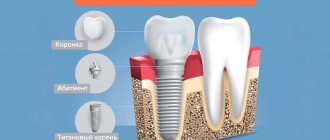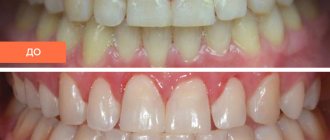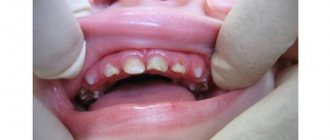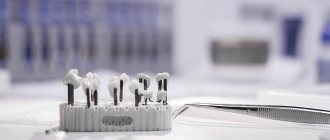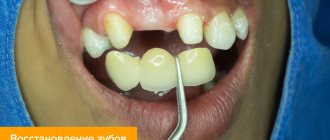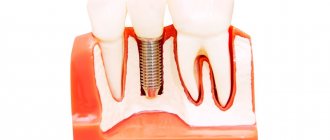Diastema (popular name gap) is an abnormal arrangement of the front incisors, which is characterized by the formation of a gap between them. Pathology of the interdental gap occurs in 15% of people. Half of these patients acquired this feature due to heredity. Only a small percentage comes to terms with their peculiarity. The rest begin to develop severe complexes, which leads to psychological disorders. Many people often confuse pathology with another diagnosis – trema. You can learn about the reasons for the formation of diastema, its types, symptoms and methods of correction from this article.
What is the correct name for the gap between the front teeth?
What we call a gap, in the language of dentists, sounds like a diastema (diastema - translated from Greek - interval, distance).
To one degree or another, diastema occurs in almost every fifth adult on the planet, and in every second child with baby teeth. Diastema is an abnormally large gap between the central upper or lower incisors of the dentition. Its dimensions can vary from 1 to 10 mm. But most often there are clefts ranging from 2 to 6 mm. Do not confuse a diastema with a trema, which forms anywhere in the dentition, excluding the central incisors.
Important! The gap between the front teeth in adults and children requires a preventive examination by a dentist. If the pathological process increases, a specialist may recommend removing the gap.
Important! During a dental examination, a specialist examines and classifies the diastema. Based on the complexity of the problem, the patient will be offered the most effective method of eliminating it.
Frequent associated symptoms
The problem is difficult to miss - its main symptom is a gap between the two front incisors on the upper or lower jaw. As mentioned above, the distance between them can be uniform along the entire length, but in other cases it takes the shape of a triangle, expanding towards the cutting edge. It is not recommended to ignore such a defect, even if you have no complexes about it or consider the gap to be your “highlight”. The fact is that such an abnormal arrangement of the anterior incisors will contribute to the curvature of the occlusion as a whole, namely the formation of a deep mesial, distal, open or crossbite.
This pathology often occurs with malocclusion.
Among other accompanying symptoms, experts highlight possible distortion in the reproduction of certain sounds, for example, whistling or a lisp. Such problems with diction arise only with severe pathology, and here classes with a speech therapist come to the rescue. In general, any diastema creates favorable conditions for the development of diseases of the gums and periodontal tissues, so experts strongly recommend not to ignore this phenomenon.
Types of diastemas
When faced with the problem of a gap between the front teeth, one should distinguish between false and true diastema.
- False – occurs in children with baby teeth. After they change and as the bite forms, it can go away on its own.
- True - diastema formed after the replacement of baby teeth and the formation of a bite, i.e. in adulthood. On its own, a visible gap between the teeth of an adult will not go away and needs treatment.
According to its structure, the cleft can be of two types.
- Symmetrical - a phenomenon in which the incisors change their location symmetrically with respect to each other and the conditional center of the dentition.
- Asymmetrical – a defect in which one of the front teeth retains its natural position, while the second deviates to the side, thereby forming a gap.
And taking into account the direction of the vertical axis of the anterior incisors, the classification of diastemas will be as follows.
- Lateral deviation of the crowns, in which the roots are parallel, and the incisors themselves diverge from each other, forming a gap.
- Body lateral displacement - the front teeth change their location along with the root.
- The medial inclination of the central incisor crowns is the most complex type of diastrema, in which the roots and teeth are subject to displacement. Incisors can grow to the side or rotate around their axis.
Causes of appearance - etiology
The appearance of a diastema may be associated with factors beyond a person’s control, such as heredity or congenital anomalies of the dental system. Among the possible reasons, experts in the field of orthodontics highlight the following prerequisites:
- heredity as the most common cause,
- curvature of the lateral incisors, their abnormal size,
- anomaly in the structure of the median suture,
- absence of lateral incisors,
- delayed change of milk bite,
- anomalies in the structure of the frenulum,
- pronounced discrepancy between the size of the jaws and the size of the teeth,
- molars appear too early, causing adjacent teeth to move,
- diseases of periodontal tissues.
Most often, the pathology is hereditary.
The defect may appear over time, under the influence of certain external factors. Thus, among the possible causes of diastema formation in children and adults, the most common are bad habits. This includes the habit of chewing the tip of a pencil or pen, and thumb sucking during sleep in children.
Ways to correct gaps between teeth
Diastema correction is a jewelry process whose main goal is to achieve the most even and perfect alignment of the central incisors. Depending on the complexity of the problem and the age of the patient, it may take 1 – 2 procedures or last for several years. The following methods of correcting the defect are recognized as the most effective and popular.
1. Braces
To close the gap, the patient may be offered to wear braces - a non-removable orthodontic structure that allows you to straighten the dentition and give the correct position to the incisors. It is attached to the outside or inside of the teeth and can be completely invisible. Braces show the greatest effectiveness at the age of 16 years, while the bone tissue of the jaw is not yet fully formed. Wearing braces for adult patients is often unjustified, since after the orthodontic system is removed, the incisors may gradually return to their original position and form a gap again. The average cost of treatment is 50,000 rubles (prices are current for 2018).
Advantages of braces systems
- Safely.
- Effective.
Flaws
- Duration of wearing can reach 3 years.
- More careful and thorough oral care is needed.
- Do not remove until the end of treatment.
2. Records
A removable orthopedic structure, the operating principle of which is similar to braces. The plate, equipped with “hand-shaped processes,” pushes the problematic incisors in the right direction and gradually they take the correct position. It is most advisable to use plastic surgery at an early age - up to 12 years, while the bone tissue of the jaw and the position of the teeth are well amenable to correction. The average cost of treatment is 30,000 rubles (prices are current for 2021).
Advantages
- Safely.
- Effective.
- You can shoot.
Flaws
- Suitable only for correcting minor defects.
3. Mouth guards
Removable aligners are orthodontic structures that are a kind of “covers” that are put on the teeth. Manufactured using 3D technology, they apply the necessary pressure to problematic incisors, thereby moving them in the desired direction. By successively replacing the mouth guards in size, from larger to smaller, the gap is eliminated. The average cost is 150,000 rubles (prices are current for 2021).
Advantages
- Safely.
- Effective.
- You can shoot.
- Transparent aligners are invisible on the teeth.
Flaws
- Cost of treatment.
4. Veneers
Veneers are microprostheses that act as a kind of facing material for the outer surface of problem teeth. Their installation allows you to close the gap, in the literal sense of the word. Made from modern, reliable materials, they do not cause allergies and are completely invisible on the dentition. The average cost of closing a diastema is 30,000 rubles (prices are current for 2021).
Advantages
- Safely.
- Effective.
- Large selection of materials and colors of veneers.
- Quick visible results.
Flaws
- Pre-grinding of the incisors is required.
- After about 10 years, the veneer will wear out and will need to be replaced.
- There are contraindications - bruxism, increased tooth wear. An extreme lifestyle is also a limitation.
5. Lumineers
Lumineers are an orthopedic overlay, somewhat similar to veneers. Like them, lumineers are installed on the outer surface of the central incisors and completely cover the diastema. In terms of aesthetics, they are superior to veneers and allow you to get a sparkling Hollywood smile. The average cost of installation is 30,000 rubles (prices are current for 2021).
Advantages
- Safely.
- Effective.
- Quick visible results.
- No pre-grinding is required.
- Average service life is 20 years.
Flaws
- There are contraindications - bruxism, increased tooth wear, extreme lifestyle.
6. Crowns
Crowns are permanent orthopedic structures that completely cover the incisor, allowing the gap to be closed. They can be made of plastic, ceramics, metal or combined materials. The average cost of 1 crown is 20,000 rubles (prices are current for 2021).
Advantages
- Safely.
- Effective.
- Large selection of materials.
- Quick visible results.
- Invisible on the dentition.
- Can be installed on damaged teeth (up to 60% destruction is allowed).
- Average service life is 10 – 20 years.
Flaws
- Pre-grinding of the tooth is required.
7. Implants
Implants are non-removable orthopedic structures designed to replace missing teeth that have caused the formation of a diastema. An implant embedded in the osseous tissue of the jaw replaces the roots of the tooth, allowing you to completely restore the functionality and aesthetics of the crown of the problematic incisor. The average cost of prosthetics is 40,000 rubles (prices are current for 2018).
Advantages
- Safely.
- Effective.
- Large selection of materials.
- Quick visible results.
- Lifetime service life.
Flaws
- Postoperative observation is required.
- There are contraindications.
8. Cosmetic correction
This method is effective for minor diastemas. In this case, the dentist simply places a small filling in the space between the incisors, thereby visually eliminating the problem. The average cost of closing a diastema is 3,000 rubles (prices are current for 2018).
Advantages
- Safely.
- Effective.
- Quick visible results.
- No contraindications.
Flaws
- Over time, the filling may change its color, disrupting the aesthetics of the dentition.
- Average service life is 5 – 7 years.
- It is necessary to control (reduce) the load on the front teeth at the moment of biting.
- Risk of developing caries at the junction of the incisors.
9. Artistic restoration
Unlike cosmetic correction, artistic restoration is more durable. During the restoration process, the dentist builds up the tissue of the front teeth using layer-by-layer application of composite materials. Hardening under the influence of an ultraviolet lamp, they look natural, like part of a tooth, and create the effect of a tight closure of the incisors. The average cost of such aesthetic camouflage of a defect is 12,000 rubles (prices are current for 2021).
Advantages
- Safely.
- Effective.
- Quick visible effect.
- The buildup is invisible on the surface of the tooth.
- No contraindications.
Flaws
- It is necessary to control (reduce) the load on the front teeth at the moment of biting.
10. Surgical plastic surgery
Surgery is necessary when the diastema is formed due to improper position of the labial frenulum. A low-attached frenulum simply will not allow the incisors to close, and they will form a gap. To eliminate a congenital defect, specialists perform frenuloplasty - the distance between the front teeth is reduced naturally and they take the correct position. After plastic surgery, you may need to wear orthodontic appliances. The average cost of the operation is 7,000 rubles (prices are current for 2021).
Advantages
- Safely.
- Painless.
- Effective.
Flaws
- The duration of elimination of diastema may take several years.
advantages
Important! The sooner the incorrect location of the frenulum is detected, the easier it is to correct the defect. The ideal age for this is 5–8 years. The frenuloplasty performed during this period promotes independent closure of the incisors, without wearing orthopedic structures. At an older age, and even more so in adult patients, the teeth will need help - the incisors must be guided and brought together using braces, plates or aligners.
Ceramic veneers for diastema
The problem is eliminated for a long time. But they will require more financial and time costs. To correct a small gap, two veneers will be enough only for the central two teeth: For a large distance, you will have to make veneers for four incisors: how to do it
- The dentist treats the outer surfaces of the teeth. He takes impressions and fixes the veneers to the teeth at the next meeting.
deadlines
- On average 3-7 days.
- If necessary, while prosthetics are in progress, temporary veneers are made from composite material.
pros
- They do not require high manual skills and experience from the doctor as with direct veneers.
- There is less plaque formation on ceramics than on your own teeth. It will never change color.
- You can change the color of your front teeth - make them lighter.
minuses
- The outer surfaces of the teeth are completely processed. There is an effect on the nerve of the tooth.
- If teeth are restored with large fillings, crowns will have to be made.
- Ceramic is a fragile material, so you will have to avoid biting into overly dense foods.
price
- For one veneer from 16,000 rubles and above.
forecast
- Service life up to 10 - 16 years.
- If damaged, they are completely rebuilt.
Negative consequences of diastema
In addition to aesthetic discomfort and impaired pronunciation of whistling sounds, the gap between the teeth causes inflammation of the gums and periodontium in this area.
Due to injury while eating. This will lead to gradual exposure of the roots of the front teeth. A short frenulum of the lip causes a greater negative impact. If attached close to teeth. It has a constant traumatic effect on the gingival margin around the teeth, causing chronic periodontitis. Then exposure of the roots occurs with bone tissue atrophy. And fast enough.
Prevention of diastema in adults
The distance between the central teeth appears in adulthood. There are several reasons:
- partial absence of chewing teeth,
- their destruction
- severe wear of teeth or fillings.
Then the front teeth begin to take on more chewing load.
If they do not have time to wear off, then they become compensatory. Provoking tilting of teeth and the appearance of gaps between teeth. This can be prevented by restoring the chewing function of the lateral teeth, avoiding overloading the front teeth.
Cost of treatment in our clinic
The cost of eliminating the gap between the front teeth is determined based on the following factors.
- Complexity of the problem.
- Elimination method.
- Cost of consumables and medications.
In this table you can see the approximate prices of various methods of correcting a defect.
| Remedy | Prices |
| Braces | From 16,000 rubles |
| Records | From 20,000 rubles |
| Mouth guards | From 130,000 rubles |
| Surgical plastic surgery | From 5000 rubles |
| Veneers | From 20,000 rubles |
| Lumineers | From 20,000 rubles |
| Crowns | From 18,000 rubles |
| Implants | From 30,000 rubles |
| Cosmetic correction | From 2000 rubles |
| Artistic restoration | From 10,000 rubles |
How to correct a defect in childhood
When diagnosing a diastema in a child, a specialist determines whether it is true or false. To do this, you will have to undergo an x-ray examination and send the image to the doctor for examination. With a true diastema, the seam between the incisors will be clearly visible in the picture. Once it begins to fill with connective or bone tissue, a corticotomy will be required. This procedure involves surgery to correct the palatal suture. All manipulations are performed under anesthesia, but you need to prepare for the fact that the rehabilitation period may be accompanied by discomfort and moderate pain.
However, today in pediatric dentistry a different method of solving the problem is successfully used. A special retainer made of carbon thread helps to avoid surgical intervention. The doctor carefully places a rubber structure on the incisors and leaves it for about a week. After this, the specialist removes it and replaces it with a retainer, with which the child will have to walk for about a year.
The photo shows a clamp for eliminating the gap
In the event that the pathology is formed due to too large sizes of the temporary incisors, their premature removal is prescribed. The measure is radical, but it allows the remaining permanent teeth to grow and form correctly.
Is it possible to remove a hole between teeth at home?
No!
You cannot get rid of the gap between your front teeth on your own, with the help of folk remedies, spells and other “miraculous” techniques. The exception is false diastema, which disappears on its own as the child grows older. Important! You should not tie the front teeth with a tight thread, trying to force them closer to each other. In childhood, this will cause improper formation of the jaw and unnatural position of the teeth. In adult patients, this leads to loose teeth. In patients of all age groups, this method of eliminating diastema can lead to the development of caries and periodontitis.
Important! If you encounter one or more causes of a gap, you should immediately consult a dentist.
Trema and diastema - what's the difference?
In orthodontics there is also the concept of “trema”. It is often confused with diastema, but they are not synonymous. Tremas are diagnosed in cases where the patient has too large gaps between the teeth - often they are observed along the entire length of the row. Diastema is a gap between the front central incisors. Thus, the main difference lies in the location of the defect.
The photo shows a diagram of the difference between a trema and a diastema
Why does a gap appear between the front teeth?
The formation of diastema is influenced by a number of negative internal and external factors. The most likely reasons for the appearance of a gap are:
- Genetic (hereditary) predisposition.
- Too pronounced interdental papillae.
- Incorrect position of the lip frenulum.
- Late change of primary teeth.
- Slow growth and formation of central incisors.
- Partial or complete absence of teeth as a result of abnormal formation of the dental system.
- Pathological arrangement of teeth.
- Gum pathologies.
- Presence of supernumerary teeth.
- Microdentia – the patient’s teeth are small in size.
- Bad habits – chewing, sucking, etc.
- Injuries to the front teeth.
Methods of prevention and prognosis
To prevent the development of diastema, you need a little:
- eliminate bad habits in the child that can affect the proper growth of teeth (wean the baby from sucking fingers and biting other hard objects);
- take care of regular visits to the dental office (this is especially important for those patients who already have this pathology in their family).
Diastema has a wide variety of clinical forms. Therefore, in order to achieve a good result in treatment and a favorable prognosis, you will need to select the optimal solution to the problem and clearly follow the sequence of all stages of treatment. Correctly carried out treatment will relieve the patient of shortcomings associated with sound reproduction and psychological complexes, and will also help achieve maximum aesthetic results.
Diastema is completely eliminated in any, even the most severe case. The price of treatment is low and depends on the complexity of the case. This takes into account the cost of all examination procedures and materials used, how many stages of treatment will have to be completed and how they are followed. Also, the professionalism of doctors and the status of the clinic can play a big role in the price.
Sources used:
- Kina Sydney. Invisible aesthetic ceramic restoration. M.: Geotar-Media, 2010
- Borisenko A.V. — Secrets of caries treatment and dental restoration. -M. Book plus. – 2005.
- Wheeler, Bryan; K. Carrico, Caroline; Shroff, Bhavna; Brickhouse, Tegman; Laskin, Daniel (2017-11-01). "Management of the Maxillary Diastema by Various Dental Specialties". Journal of Oral and Maxillofacial Surgery.
How to prevent a gap in a child?
Caring parents should adopt a few simple rules that will help avoid the formation of diastema.
- Regular examination by the dentist, which is especially important if the child is genetically predisposed to the appearance of a gap - every 6 months.
- Strict adherence to the rules of oral hygiene.
- Providing adequate nutrition for the child with foods high in calcium, magnesium, fluorine, phosphorus, vitamins D, C, A.
- Try to stop your child’s bad habits - sucking objects, fingers, chewing pencils, seeds, nuts, etc. with his front teeth.
Important! An earlier visit to the dentist allows you to avoid the final formation of a diastema and will help eliminate any defects in the dentition.
Restoration of diastemas with composite material
When all the teeth are in a normal position and the only concern is the distance between the front teeth, this can be beautifully, easily and quickly corrected with a composite material. In the patient's mouth for an hour and a half. This type of correction is called a filling, artistic restoration, or direct veneer. how it's done
- A composite material is applied to the lateral surfaces of the teeth without treatment, changing their shape and closing the gap between the teeth.
deadlines
- It will take one to two hours for both teeth.
pros
- This is the most non-traumatic
way to eliminate diastema. - The fastest way to close diastemas of all.
- Complete absence of dental treatment. No boron! Absolutely atraumatic for teeth and their nerves.
- No negative impact on the tooth and nerve.
- The likelihood of dental problems is the same as without intervention.
- The strength of the teeth is not impaired - you can bite off any acceptable food.
minuses
- We need a highly qualified dentist. With a lot of experience. Otherwise, closing the diastema will look like a filling and not an artistic restoration.
- The doctor must have a variety of aesthetic and proven materials available. To eliminate the defect beautifully and permanently. If performed poorly, the appearance of the teeth will not be ideal.
- When the distance between the front teeth is more than 2mm, the results are not always ideal:
In such cases, treatment with braces is more suitable. Or you have to use the lateral incisors. To prevent the central ones from becoming too wide: cost
- 6600-13200 rubles for one direct veneer. Depends on the scope of the intervention.
forecast
- When the work is done by a true master, composite veneers will last up to 10 - 16 years.
- Poor oral hygiene may require polishing. Once every two to four years. Takes 15-20 minutes. Costs up to 600 rubles.
- Due to the lack of treatment of the teeth, there is no effect on the nerve of the tooth. Therefore, there can be no complications.
Consequences
Whether to correct a diastema or not is a personal matter for each patient. But it is necessary to understand that its existence may have a number of undesirable consequences and complications.
- Violation of the aesthetics of the dentition.
- Formation of malocclusion.
- Impaired diction.
- Development of caries and periodontitis.
Not to mention the fact that a gaping gap between the front teeth can cause psycho-emotional experiences for its owner and cause the formation of serious complexes.
Important! Over time, even a minor diastema can increase in size, which will require its correction and treatment.
How is diagnostics carried out?
To diagnose an anomaly, the dentist only needs to conduct a standard visual examination. No additional tests or other diagnostic procedures are required. If the patient decides to correct the problem, the specialist will need to carefully study the clinical picture. It is necessary to determine the position of the center line, establish the type of defect and the cause of its occurrence. Therefore, the following diagnostic measures may be required:
- X-ray examination, including orthopantomogram or CT scan,
- taking impressions of both jaws,
- careful analysis of the inclination and shape of the incisors,
- determination of the symmetry of the gap, the condition of the roots and the bite in general.
To diagnose the problem, it is necessary to take impressions.
Today, dental practice uses various methods for correcting such a defect. The patient may need to consult not only an orthodontist, but also a surgeon and an orthopedist.
Fashion trends: keep or get rid of?
Patients with complaints about an unattractive smile could often be helped by a psychologist as well as a dentist; 40% of diastema owners easily get along with this feature.
Film actors Nikolai Karachentsov and Konstantin Raikin smile broadly on the screen, showing off their diastema to everyone. Ornella Muti, Madonna and Vanessa Paradis built successful careers without looking back at her.
Following the example of Australian fashion model Jessica Hart, many celebrities have abandoned the correction of their natural bite, maintaining the diastema as a sign of individuality.
Smiles of those with gap hair - show business stars
But Alla Pugacheva did not put up with such a feature, although she came to the height of fame with a diastema.
The final result of diastema treatment.
Image 51
Image 52.
Image 53.
Image 54.
Image 55.
Image 56.
Image 57.
Image 58 - Final result.
Which method is better?
The only reliable method of completely eliminating gaps between teeth is orthodontic treatment. Only it can cure pathology, and not just disguise it. This treatment is the most long-term method of correcting three. However, it is less traumatic for teeth, since it does not require turning, grinding and other procedures required for aesthetic correction. For children under 12 years of age, dentists prescribe special orthodontic plates, which they wear for some time. From the age of 13, braces are allowed. Thus, trema can be cured only with the help of special orthodontic structures that will need to be worn for a certain time. Aesthetic correction methods, such as installing veneers, crowns or extensions, do not eliminate the problem, but only make it invisible to others. The patient and the doctor decide which method to use. If the three holes are not very large and do not cause problems, you can limit yourself to installing veneers or extensions. If the defect is severe or causes discomfort, you will have to undergo orthodontic treatment. After it, the teeth will take the correct position, and the gaps between them will disappear.
Plates are removable orthodontic structures used to treat dental anomalies. They are completely safe because they do not provoke allergic reactions and do not injure the oral mucosa.
